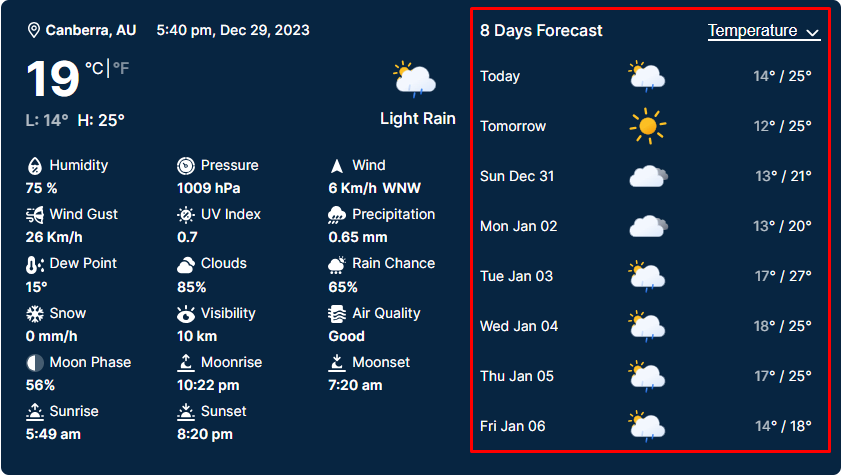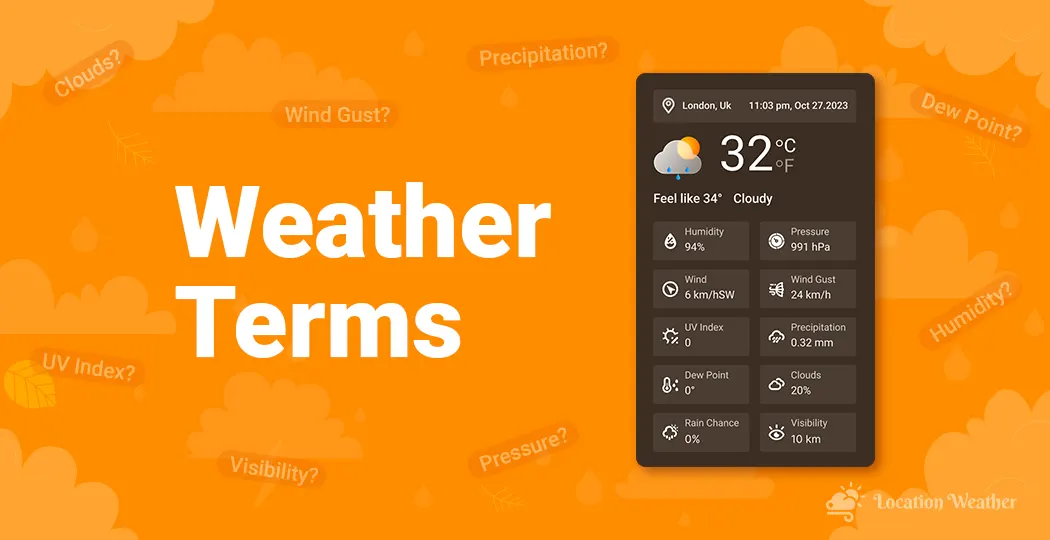You can use Ctrl+F to quickly find the weather terminologies you are looking for.
An accurate understanding of weather terminologies is crucial for weather forecast designers as well as meteorology students.
The mostly used weather description words are:
Air Quality
Air quality refers to the air’s overall condition, explicitly measuring the levels of pollutants and their impact on the environment and human health. Usually, the levels of air quality are
- Good
- Fair/Satisfactory
- Moderate
- Poor
- Very poor
Clouds
A visible mass of condensed water vapor floating in the atmosphere, typically high above the ground. It’s expressed in percentage.
Coordinates
Coordinates in weather are two numbers that pinpoint a specific location on Earth’s surface. Basicly, these two numbers are expressed in degrees of latitude and longitude.
Latitude:
Latitude measures the north-south position of a point relative to the equator. It is expressed in degrees from 0° at the equator to 90°N at the North Pole and 90°S at the South Pole.
Longitude:
Longitude measures the east-west position of a point relative to the prime meridian (usually the Greenwich Meridian). It is also expressed in degrees from 0° at the prime meridian to 180°E or 180°W.
However, coordinates are often written in the format (latitude, longitude) or (latitude°, longitude°). You may need to use coordinates to accurately pinpoint locations, especially those with no name to define.
Dew Point
The atmospheric temperature (varying according to pressure and humidity) level below which water vapor begins to condense and turns into dew.
For example, if the air temperature is 21.1 degrees Celsius and the dew point is 15.6 degrees Celsius, the air is 10% saturated with water vapor. If the air is cooled to 15.6 degrees Celsius, the air vapors will form dews.
Forecast
A weather forecast is a prediction or estimate of upcoming weather at a specific location and time. It can cover various aspects of the weather, including temperature, precipitation, humidity, and so on.

In addition, you can read the best weather units to use for details on weather unit terminologies.
Humidity
Humidity refers to the amount of moisture or water vapor in the air. It influences weather patterns and can impact how humans perceive temperature and comfort. Humidity is expressed in percentage.
Moon Phase
The moon phase refers to the appearance of the illuminated portion of the Moon as viewed from Earth. To clarify, the moon goes through a regular changing phase cycle as it orbits the Earth. However, these phases result from the varying positions of the Moon, Earth, and the Sun, which cause different portions of the Moon to be lit by sunlight.
Moon phases’s measurement unit is percentage that shows the new moon, first quarter moon, full moon, and last quarter moon, etc.
National Weather Alert
A National Weather Alert is a formal announcement by a national meteorological agency or other relevant authorities to warn the public about significant and hazardous weather conditions. Moreover, these alerts provide timely information and instructions to help people prepare for and respond to adverse weather events.
OpenWeatherMap
Open Weather Map is a free and paid weather API key provider. With the API key, you can easily add a weather forecast widget to your website.
Precipitation
A liquid or solid form of water that falls from the atmosphere to the Earth’s surface. It is a vital component of the Earth’s water cycle and includes several forms, such as rain, snow, sleet, hail, and drizzle.
Pressure
In weather, Pressure refers to atmospheric or air pressure exerted by the weight of the air at a particular location. Air pressure’s measurement units are Millibars (mb), Hectopascals (hPa), Inches of mercury (inHg), or more. However, there are a few more options that many countries and communities use.
Rain Chance
Rain chance, also known as precipitation probability, refers to the percentage likelihood of rain occurring at a specific location.
Real Feel
“Real Feel”, also known as the “feels like” temperature, is a measure to describe how the weather actually feels to a human rather than just relying on the air temperature measurement tool. However, it considers several factors beyond just the number on the thermometer to predict how comfortable or uncomfortable you might be outside.
Temperature
Temperature is the atmospheric condition that denotes how warm or cold the air is at a location. It’s measurement units are Celsius (°C), Fahrenheit (°F), or Kelvin (K).
Time Zone
A time zone is a particular area of the Earth that has the same standard time. It is defined by the longitudinal position of a location relative to the Prime Meridian (0 degrees longitude). The Earth is divided into 24 time zones, each representing one hour difference from the adjacent zone.
UV Index
The UV index is a measure of the intensity of the ultraviolet (UV) radiation reaching the Earth’s surface from the sun. It’s a scale that tells you how intense the sun’s UV rays are at a particular time and place.
The UV index ranges from 0 to 11+, with higher numbers indicating greater intensity of UV radiation.
- 0-2: Low risk
- 3-5: Moderate risk
- 6-7: High risk
- 8-10: Very high risk
- 11+: Extreme risk
Visibility
Visibility in weather refers to the distance at which objects or landmarks can be seen and identified in the atmosphere. It’s measurement units are kilometers and miles.
Weather Attribution
Weather Attribution refers to assigning credit to the weather data provider.
Wind Gust
A sudden increase in wind speed, usually lasting less than 20 seconds.
Wind Speed
Wind speed refers to the rate at which air moves horizontally past a given point at a specific location and time.
Let me know what weather terminologies you were looking for. We love to read your comments and reply to them.
You can add accurate weather forecasts to your WordPress website in minutes with the best weather plugin.

Leave a Reply